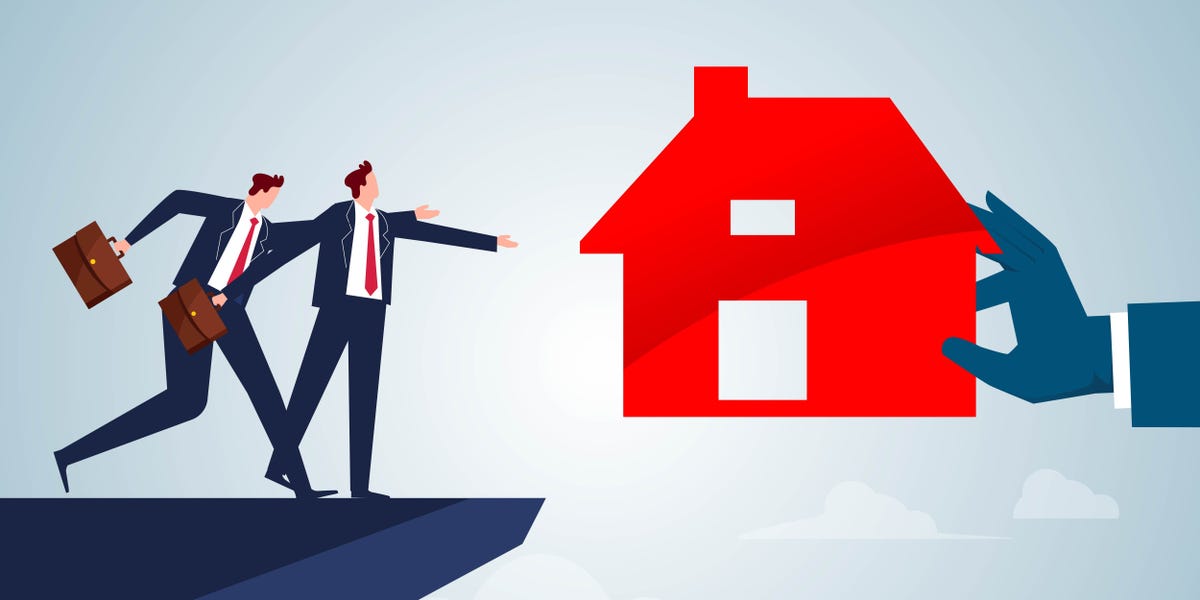- A group of economists may have figured out why there’s been a disconnect between American consumer sentiment and the underlying economy.
- It all comes down to how experts measure inflation — and what they leave out.
- The economists said rising borrowing costs explain over 70% of the sentiment gap.
Thanks for signing up!
Access your favorite topics in a personalized feed while you’re on the go.
download the app

Over the past year, experts have puzzled over the disconnect between how Americans say they feel about the economy and the hard economic data that suggests things are going pretty well.
While sentiment has improved a bit in recent months, the “vibecession” still lingers in economists’ minds. Now, a group of them has created an interesting model that suggests much of people’s dissatisfaction with the economy comes down to interest rates.
In a working paper published in February by the National Bureau of Economic Research, the authors, economists from Harvard University and the International Monetary Fund, analyzed whether elevated interest rates could have fueled Americans’ frustrations with the economy.
To do this, they developed their own inflation calculation, which incorporated rising borrowing costs for things like home and car purchases. They then made two separate predictions of economic sentiment — using both their new inflation measure and the official Bureau of Labor Statistics consumer price index — and compared them to the University of Michigan’s consumer sentiment index, an oft-cited gauge of economic vibes.
When the economists used the official CPI measure, there was a large gap between predicted and actual sentiment. But when they used their revised inflation measure, they found that the 2023 sentiment gap closed by over 70% — suggesting this was a more accurate way to gauge how Americans feel about the economy.
In short, the US’s standard measure of inflation doesn’t capture how much more expensive it is to be in debt these days, even though this could be a major factor explaining Americans’ dissatisfaction with the economy.
“There still seems to be a little bit of excess gloominess or bad vibes given the hard data, but nowhere near as large as we would have gotten if just looking at inflation or unemployment,” Judd Cramer, a Harvard economist and coauthor of the paper, said on an episode of the “Plain English” podcast released on March 5.
The US’s popular inflation measure no longer accounts for interest rates
While Michigan’s consumer sentiment index has ticked up in recent months, Americans were still more sour on the economy in February than they were every month between December 2013 and early 2020 — when the pandemic caused sentiment to plunge.
Traditionally, many economists have used the “misery index” — which adds up the inflation and unemployment rates — as one tool to measure the health of the US economy. When prices are high and a lot of people are unemployed, things probably aren’t going well.
But the paper’s authors, which included former Treasury Secretary Larry Summers, said the misery index has a key shortcoming, one that motivated them to develop an alternative inflation measure: It no longer accounts for interest rates.
In 1983, the BLS changed how it calculated inflation. Among the biggest tweaks was how it determined shelter inflation — one of the largest parts of the consumer price index that’s supposed to reflect Americans’ housing costs.
Before the change, housing prices and mortgage rates were among the components used to determine shelter inflation. But following the BLS’s change, which was made in part because many people view housing as an investment — not solely as consumption — things changed.
Today, shelter inflation is calculated using rent prices and the equivalent cost to rent an owned home. It means that the surging mortgage rates — driven partly by the Federal Reserve’s inflation-fighting interest-rate hikes — haven’t directly impacted shelter inflation, even though they’re among the key reasons mortgage payments reached record levels last year.
In fact, the impact of rising interest rates isn’t directly accounted for anywhere in the official CPI report — even though they’ve also contributed to surging car payments and made credit card debt much more costly.
“As Americans have seen interest rates on their credit cards or on their car loans or on their mortgage rates shoot up in the post-pandemic period, that hasn’t been reflected in the CPI,” Harvard’s Cramer said.
That’s why the economists developed their own inflation measure, and they think it provided a more accurate prediction of economic sentiment.
“If we include interest rate costs into the consumer price index, similarly to how it was done in the 1970s, then it turns out the economy is not as great as everybody has been saying,” Cramer said. “And consumers’ gloomy moods are a little more explainable given they’ve been having to deal with these higher interest rate costs over the last few years.”
Cramer said additional evidence for the impact of interest rates on consumer sentiment has come in recent months. Between November and January, the Michigan consumer sentiment index saw its biggest two-month increase since 1991 — just as mortgage rates fell from their recent peak.
Given the impacts of interest rate spikes on people’s pocketbooks, Cramer said it’s not surprising that they seem to have impacted how Americans feel about the economy. He said he and his fellow coauthors found that rising rates similarly impact sentiment in other countries.
Elevated interest didn’t entirely explain the gap between hard economic data and sentiment — some have pointed to a rise in political partisanship and negative media coverage as other explanations.
But if the Federal Reserve does start cutting interest rates this year as many expect — and this leads to lower borrowing costs for mortgages, car loans, and credit card debt — this could make some Americans feel better about the economy. And it could be good news for President Joe Biden’s reelection chances.
“If and when they do start to cut rates, I do think that’s going to do a lot to buoy not only the real economy but also how people interpret the economy,” Cramer said.


